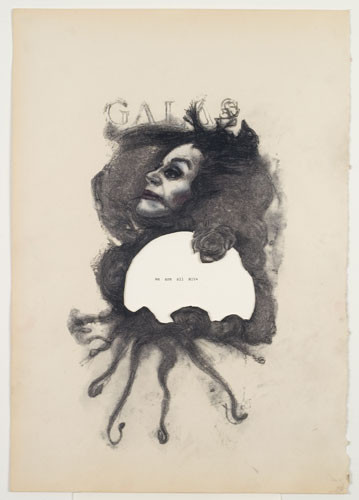Jean-Luc VERNA
21 Apr - 26 May 2007

© JEAN-LUC VERNA
Galas (HIV), 2007
transfert sur papier ancien rehaussé de crayons et de fards, collage, cadre chêne et verre, 57,5 x 43 cm
Galas (HIV), 2007
transfert sur papier ancien rehaussé de crayons et de fards, collage, cadre chêne et verre, 57,5 x 43 cm
JEAN-LUC VERNA
"Vous n'êtes pas un peu beaucoup maquillé ?" - "Non."
When Nina Hagen, in one of her concerts, took up the same pose as Degas's Little dancer aged 14 , and Siouxsie, playing the tambourine, adopted those of the nymphs in Jean Goujon's The Fountain of the Innocents, they were doing so unwittingly. Jean-Luc Verna studied these concerts attentively, and looked through catalogues and art reviews for gestures that were common to the two worlds.
All of Verna's work involves encounters between the art of the past and the music of the present. He tracks down congruences between poses from the history of art and the rock music world, and gives his own interpretation of them. In these appropriations - these incarnations - he synthesises two images into a third, with himself as both author and actor. Remakes and tributes to established masters are recurrent both in the visual arts and in music. And Verna has also recorded songs by his idols, besides giving concerts in several art venues. Re-use comes into his photographs, but also his drawing, which are always based on different-sized photocopies of matrices transferred to a backing and enhanced with cosmetics. For I Apologize , choreographed by Gisèle Vienne, he struck a series of poses from the history of art and rock while perched on a pile of wooden cases, bare-chested but wearing black jeans and Getta Grip boots. The production, the dancing and the gestures fused his different artistic activities in a number of ways.
Taking as his source figures apparently sketched from life, Verna looks backwards, in a way, to a preliminary stage in the development of the work. This is a retrospective process, a stripping-away in order to approach the body of a model or a singer. [...] He traces out a prestigious genealogy, settles scores, writes his own history of art and rock music, displaces and reactivates characters and their authors in the field of contemporary art. He pays tribute, while at the same time creating a repertoire of possible poses, and builds bridges between different artistic and historical domains. As with the drawings, he welds together two distinct forms of theatricality by embodying them outside of time. This improbable fusion takes shape through photography, a medium which, of course, has a history of its own. [...]
Draughtsmanship is Verna's central interest, but his photographs of poses from the history of art and rock music are part of the same ballet as the angels, ghosts, spectres and fairies that he choreographs on walls, alone or in twos or threes. These images, which owe something to both erudition and popular culture - the old and the new - make up a fantastical galaxy of disparate worlds brought together in a state of coherence.
"Vous n'êtes pas un peu beaucoup maquillé ?" - "Non."
When Nina Hagen, in one of her concerts, took up the same pose as Degas's Little dancer aged 14 , and Siouxsie, playing the tambourine, adopted those of the nymphs in Jean Goujon's The Fountain of the Innocents, they were doing so unwittingly. Jean-Luc Verna studied these concerts attentively, and looked through catalogues and art reviews for gestures that were common to the two worlds.
All of Verna's work involves encounters between the art of the past and the music of the present. He tracks down congruences between poses from the history of art and the rock music world, and gives his own interpretation of them. In these appropriations - these incarnations - he synthesises two images into a third, with himself as both author and actor. Remakes and tributes to established masters are recurrent both in the visual arts and in music. And Verna has also recorded songs by his idols, besides giving concerts in several art venues. Re-use comes into his photographs, but also his drawing, which are always based on different-sized photocopies of matrices transferred to a backing and enhanced with cosmetics. For I Apologize , choreographed by Gisèle Vienne, he struck a series of poses from the history of art and rock while perched on a pile of wooden cases, bare-chested but wearing black jeans and Getta Grip boots. The production, the dancing and the gestures fused his different artistic activities in a number of ways.
Taking as his source figures apparently sketched from life, Verna looks backwards, in a way, to a preliminary stage in the development of the work. This is a retrospective process, a stripping-away in order to approach the body of a model or a singer. [...] He traces out a prestigious genealogy, settles scores, writes his own history of art and rock music, displaces and reactivates characters and their authors in the field of contemporary art. He pays tribute, while at the same time creating a repertoire of possible poses, and builds bridges between different artistic and historical domains. As with the drawings, he welds together two distinct forms of theatricality by embodying them outside of time. This improbable fusion takes shape through photography, a medium which, of course, has a history of its own. [...]
Draughtsmanship is Verna's central interest, but his photographs of poses from the history of art and rock music are part of the same ballet as the angels, ghosts, spectres and fairies that he choreographs on walls, alone or in twos or threes. These images, which owe something to both erudition and popular culture - the old and the new - make up a fantastical galaxy of disparate worlds brought together in a state of coherence.
